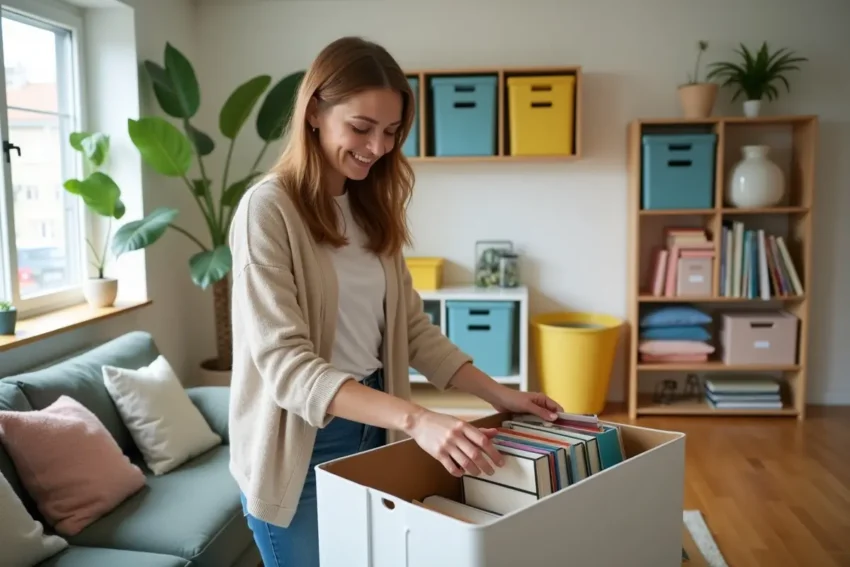A Step-by-Step Plan to Organize Your Entire House

Every homeowner knows the challenge of keeping up with household organization. Without intentional effort, our spaces can descend into chaos. Whether you’re preparing for a season change or simply seeking a tidier environment, organizing your home can yield remarkable improvements in both aesthetics and functionality.
This article presents a detailed plan to systematically declutter and organize your house room by room.
Contents
Create a Master Plan
A well-structured plan is your first step toward achieving organization. Begin by identifying the areas in your home that need the most attention. Make a list detailing rooms like the kitchen, living area, bedrooms, and bathrooms. Break down the tasks into smaller, manageable steps to tackle each section without feeling overwhelmed.
Having a clear roadmap also helps track your progress and serves as a motivational tool. This roadmap might include specific goals such as “tackle the living room by Saturday” or “finish organizing the garage by the end of the month”, creating a timeline for completion.
With your plan in hand, consider the resources required for the organization. Investing in storage solutions can help simplify the process. Items like bins, baskets, and shelving units keep belongings compartmentalized.
Categorizing kitchen items by frequency of use means those you reach for daily are easily accessible, reducing time spent hunting for cooking essentials. Consider using Loxon Storage in Ipswich to temporarily house items during your organization’s efforts, creating an uncluttered work area. Finding proper storage solutions can enhance efficiency.
Declutter Each Room
Decluttering is the heart of organizational success. Approach this step by emptying an entire room or section if manageable. Assess what you truly need and what can be discarded or donated. Most professional organizers advocate for the “one-year rule”: if you haven’t used an item within one year, it might be time to part ways with it.
This mindset shifts the focus from complex sentimental attachments to practical necessity. Not everything has to be kept. Given that room allows only so much, it is crucial to prioritize items that add value and joy to your life.
Consider sorting items into three categories: keep, donate, and discard. During this step, it can be beneficial to have a friend or family member assist you. A fresh perspective can make decision-making easier. When sorting is complete, ensure that the donated items are taken to a local charity as soon as possible. Piles of used items easily transform into unwanted clutter if not promptly addressed.
Organize and Arrange
After decluttering, the actual organization process begins. Taking time to thoughtfully arrange the items you chose to keep is crucial. Use the categories you established during decluttering to create designated spaces for each group of items. This could mean grouping cooking items, stacking books by genre, or ensuring that similar hobby supplies are consolidated in one area. A well-planned organization system doesn’t just look good. It also serves to make finding items effortless, which is the goal of organizing.
When organizing, think vertically. Stacking bins or boxes on shelves can create floor space and an illusion of more room. For clothes, consider using drawer dividers or shelf organizers to maximize storage. Adjustable shelving allows for greater flexibility as your storage needs evolve. Label everything where applicable to offer clarity, making it simple to put things back where they belong. This practice helps other family members to understand your system.
Maintain Your Organized Space
Once your home is organized, maintaining tidiness is key. Establish simple routines that promote consistent organization. The “one in, one out” rule is an effective method for keeping clutter in check: for every new item you bring into your home, commit to removing an old one. This approach helps prevent accumulation and reminds you to think carefully about each new purchase. Scheduling monthly check-ins ensures that every area stays in order, enabling you to swiftly address any encroaching disorder before it becomes unmanageable.
Encourage the household to participate in maintaining shared areas. Assigning responsibilities helps create accountability among family members. Whether it’s a chore chart or a collaborative cleaning day, fostering a team effort results in a more livable environment for all. Consider implementing daily habits such as a fifteen-minute tidy-up each evening for a consistent upkeep experience.
Incorporate Seasonal Resets
An effective way to sustain a long-term organization is by incorporating seasonal resets. Each new season provides a natural checkpoint to reassess your home’s order. As winter transitions into spring, rotate clothing, donate unused coats, and refresh outdoor gear storage.
During summer, focus on organizing patio furniture, sports equipment, and garden tools. These resets ensure your living spaces evolve with your household’s changing needs. By aligning the organization with the seasons, you create an ongoing rhythm that makes maintenance more manageable and less overwhelming.
Celebrate Your Achievements
After all your hard work to organize, don’t forget to celebrate the achievements, big and small. Acknowledging your progress can reinforce your commitment to maintaining an organized home. Perhaps treat yourself to a favorite meal after completing the project, or take a moment to appreciate the refreshing sense of space and calm within your freshly organized environment. Keeping a visual record can serve as motivation for keeping your space tidy.
Taking before-and-after photos can underscore how far you’ve come, providing the inspiration needed to continue the upkeep. Inspired by the results, you may even consider extending your organizational efforts into other areas of your life, creating a holistic sense of order both in your home and within yourself.
Organizing your entire house may seem like a daunting challenge, but with a clear plan, steady decluttering, and consistent routines, it becomes both achievable and rewarding. By thoughtfully arranging your belongings and committing to seasonal resets, you create a space that promotes calm and well-being. The journey of organization is ongoing, but each step taken is a move toward greater clarity and harmony in your living environment.



